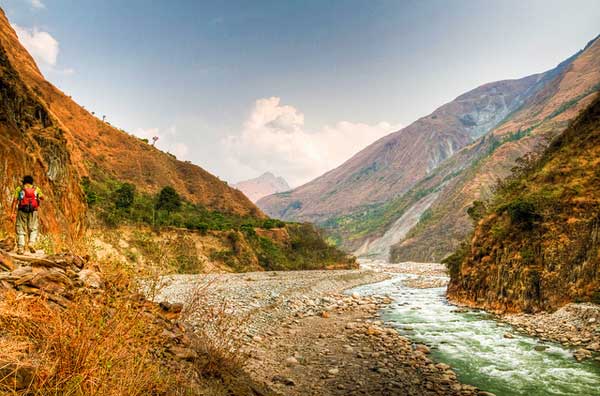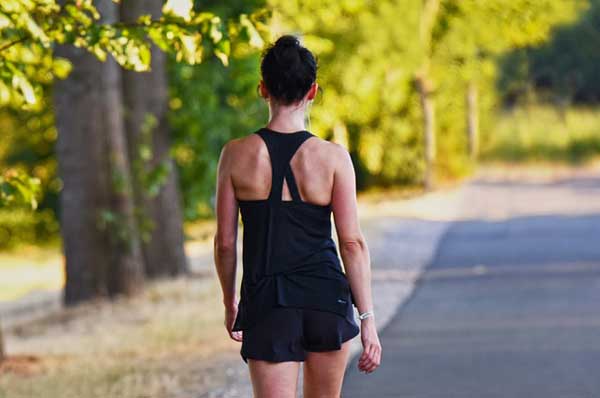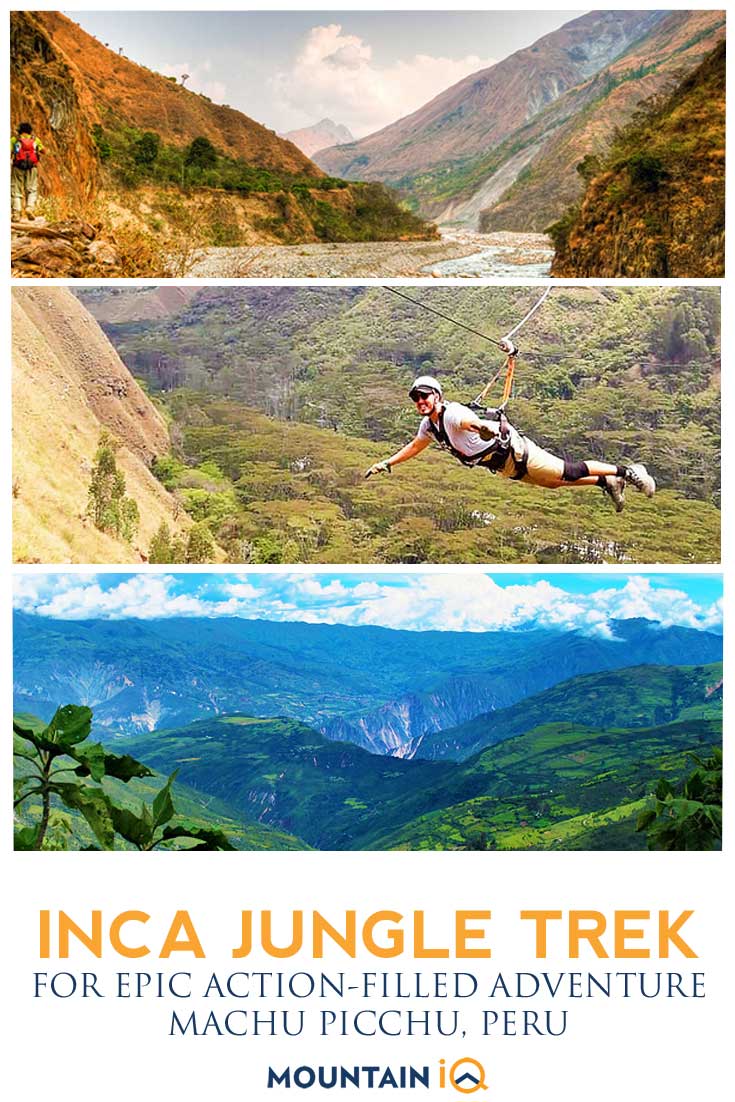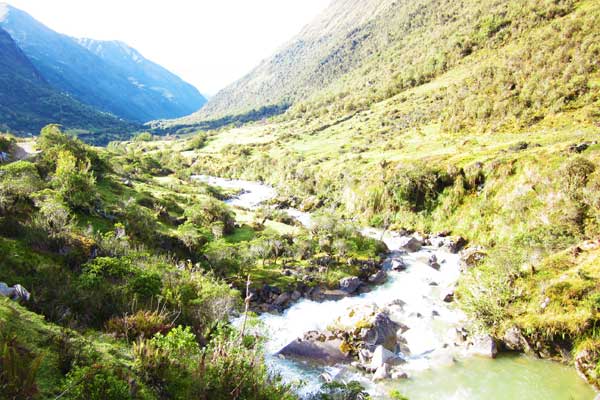If you’re planning a hike to Machu Picchu in one of South America's most beautiful mountain ranges and would like an action-filled adventure including hiking and a variety of other activities, then look no further than the Inca Jungle Trek.
This trek includes downhill mountain biking, rapid river rafting, a trek through the jungle (of course), the option of zip-lining and finally a culture-packed visit to Machu Picchu.
Inca Jungle Trail Overview
Tour companies generally offer a 4-day, 3-night itinerary, but there is the option of shortening the tour to 3 days and 2 nights.
Unlike many of the other Machu Picchu treks, the accommodation on this one is mostly in hostels and home-stays, as well as the classic night in an hotel in Aguas Calientes before your visit to the famous Incan ruin.
Below we have detailed all you will need to know for you to plan and prepare for the Inca Jungle Trek to Machu Picchu, including the typical itinerary for the 4-day option, tips to avoid altitude sickness, when to book your trip for, what to pack and how to get yourself in shape to ensure that you get the most out of your experience.
Jungle Inca Trail Itinerary Options

Photo by Ronald Woan
This is the typical itinerary for the 4-day 3-night version of the Inca Jungle Trek. The shorter 3-day, 2-night generally skips the hike from Santa Maria to Santa Theresa on Day 2 and offers car transport to Santa Theresa instead.
Day 1: Cusco to Santa Maria via the Abra Malaga Pass
Most tour companies will fetch you from your hotel in Cusco at around 7:00 to start your drive to the top of the Abra Malaga Pass.
From Cusco, you will drive north to Chinchero and then down into the Sacred Valley.
After crossing the Urabamba River, you will drive through Urabamba itself and then on through Ollantaytambo where you might stop for a quick breakfast.
Thereafter, you will continue your meandering drive up Abra the highest point on the trek (4,316m) where you will disembark, admire the extraordinary views and prepare for your exhilarating downhill cycle.
The ride itself is all downhill (a descent of more than 2,000m in altitude), and covers just less than 60km and takes 4-5 hours to finish.
The cycle is not physically arduous, as you will hardly need to peddle your wheels at all, but it can be dangerous – the roads present multiple blind corners that careless drivers are known to hurtle around.
To minimise potential risks, ensure that your tour company supplies visibility vests, quality mountain bikes and protective gear including sturdy helmets.
Your tour company may also provide a back-up vehicle in case you get tired.
One thing to remember is that if the visibility is poor due to high levels of fog, your tour company will unfortunately be forced to cancel the mountain biking and provide you with alternative transport.
You will arrive at Santa Maria at about 15:00 and possibly have the option to go river rafting if your trip is between October and April, which may cost as much as $50 per person extra.
Day 2: Santa Maria to Santa Theresa
Day 2 is a big day of trekking.
After an overnight stay in a local Santa Maria hostel (do not expect luxury) you will begin your jungle trek.
While the trail keeps at relatively low altitudes, you will hike across almost 15km of rolling hills, starting with a relatively steep climb.
Look forward to seeing an original Incan trail winding through the lush vegetation.
You will pass plantations of coca, coffee and various exotic fruits after which you will arrive in Cocalmayo, famous for its hot springs.
Here you can have a quick dip, and then continue on to your hostel in Santa Theresa where you will be staying overnight.
Day 3: Santa Theresa to Aguas Calientes via the Hydroelectric Station
Today you will have the option of zip-lining.
There are 3-5 zips as high as 150m off the jungle floor, allowing for a thrilling experience if you are that way inclined. The zip-lining might be included in your tour package, and if not costs around $40 dollars.
After gliding through the treetops, you’ll continue your hike for about 3 hours to the Hydroelectric Station from which you can either catch a train to Aguas Calientes or trek for another 2 hours until you reach your destination.
Day 4: Aguas Calientes to Cusco
Option 1: Aguas Calientes, to Machu Picchu and back to Cusco
Expect an early morning on Day 4, as buses to Machu Picchu start running at 05:30 but the bus queues start growing by 05:00.
Getting there early is advisable to catch the magnificent sunrise and get a few hours in before the crowds start thronging in the Citadel.
Upon arrival, you will be given a 2-3-hour tour of the Citadel by your tour company, or a private tour can be arranged outside the main entrance of Machu Picchu.
Remember to check if the guide you’re interested in is certified, in which case they will have a card around their necks. A private tour can cost around 100 soles so come prepared.
Option 2: Huayna Picchu, Aguas Calientes, Ollantaytambo and back to Cusco
Additionally, if you still feel like hiking, Huayna Picchu, the mountain overlooking Machu Picchu, is worth the extra hour of climbing.
If this sounds like the sort of thing you want to do, remember to book a permit early as there are only 400 available a day.
After a unique day of culture and scenic beauty, you’ll have to catch a bus back to Aguas Calientes from where you will take a train to Ollantaytambo and then finally bus back to Cusco.
Pro Trip: However, if you’re more interested in a no-frills hiking experience, then this is may not really be the hike for you. Instead, check out the Classic Inca Trail and the alternative hikes to Machu Picchu.
Inca Jungle Hike FAQ
When is the best time to go on the Inca Jungle Trek?
The Peruvian Andes are governed by two main seasons, the dry season which lasts from May to September and the wet season of October to April.
While it is possible to complete the Inca Jungle Trail at any time of the year, January and February are affected by such heavy rainfall that landslides often prohibit the use of the trail leading form Santa Maria to Santa Theresa, enforcing shutdown of the tour operations.
We recommend that you do the trek during the dry season or during March/April and October/November, when the heaviest of the rains have not yet descended on Machu Picchu.
If you are eager to include rapid river rafting into your itinerary, it is a good idea to go towards the latter end of the dry season for optimal conditions.
Although the dry season is relatively busy, the Inca Jungle Trek is not nearly as busy as the Classic Inca Trail.
However, the if you do decide to plan your trip in the peak dry season, remember that the Machu Picchu Citadel and the surrounding towns is likely to be teaming with tourists.
The temperature in the region is moderate and constant throughout the year, which average daily highs resting at approximately 22°C, and the night-time lows dropping to around 5°C.
Temperatures do occasionally drop below freezing though, so it is important that you pack clothes suitable for whatever the weather throws at you.
It is a good idea to pack layers of clothing so that you can bulk up and strip down depending on the time of day – see below on Packing for the Inca Jungle Trek.
Is altitude sickness a risk on the Inca Jungle Trek?
Altitude sicknes is a minor risk and relatively uncommon on the Inca Jungle Trek. The greatest chance of suffering from the typical nausea, fatigue and headaches is before the action even begins, while you’re in Cusco at 3,400m.
Although most of the hike is spent below 2,000m, the top of the Abra Malaga Pass is over 4,300m above sea level, so this is technically a high-altitude hike.
However, if you do encounter any of these symptoms, a rapid decent to the Sacred Valley for a day or two to recover and acclimatise will make the entire experience much more comfortable and enjoyable.
Because your proclivity to altitude sickness cannot be predicted given your age, fitness, gender or any other known trait, everyone should be made aware of the risks associated.
Make sure to educate yourself properly on the topic, but, briefly, it is important for you to stay hydrated, to avoid alcohol and drugs of any kind (including sleeping pills) and to consult a doctor if you feel anxious to take extra precautions.
What gear do I need for the Inca Jungle Trek?
The packing list for the Inca Jungle Trek is almost identical to that of the Classic Inca Trail hiking list.
Make sure to check out what our recommendations are to ensure that you are well prepared and don’t have to spend your first day in Cusco looking around frantically for bits of gear.
The main difference between the packing list for the Classic Inca Trek is that, unlike that trail, you won't need a sleeping bag, thermal mat and blankets for the Inca Jungle Trek. This is because you will spend your nights in hostels or hotels instead of in campsites.
Do I need to train for the Inca Jungle Trek?

The Inca Jungle trek is jam-packed with adrenaline-inducing, high-energy activities, so you have to at least be young at heart to enjoy it.
That being said, the physical endeavour is not particularly strenuous, so you should be able to complete the expedition with a reasonable level of fitness.
To get in shape for your hike to Machu Picchu, aerobic exercise at the gym is a great way to improve your cardiovascular strength – cycling, swimming, running or rowing are all good ways to get your heart rate up.
It is also a good idea to improve the strength of your leg muscles by doing squats and lunges.
Finally, the best way to prepare for the Inca Jungle Trek is to do one or two day-long hikes in your home country – this will give your muscles an idea of what they’re up against and it will give you an opportunity to break in your hiking shoes.
How much does the Inca Jungle Trek cost?
To judge whether you are getting your money’s worth on the tour, make sure to check what exactly is included in your tour package.
The cheapest tour operators can cost as low as $225 per person anywhere up to $700 per person for the most luxurious options.
The cheaper options generally account for any transport during the trek, 3 nights of (low-comfort) accommodation during the trek, cycling equipment and an entrance ticket to Machu Picchu.
The higher the price escalates, the better quality the gear and overnight spots become, and zip-lining, river-rafting and climbing Huayna Picchu can also be included.
All-inclusive tours in are also available from about $1000 to $1500, and these would also account for your airport transfers, accommodation in Cusco before and after the trek, as well as all the other extra cost activities detailed above.
If you have extra cash to spend on the trip, we highly recommend spending the money on these tours, as they minimize a lot of the stress of last-minute organising, and guarantee safe gear throughout.
Do you recommend reading any guidebooks before going on the Inca Jungle Trek?
Absolutely. The Peru Travel Guide by the Lonely Planet is one of the most detailed, yet easy to digest guide to the Peruvian Andes and has most of the treks and routes in it.
Other Hiking Articles:


